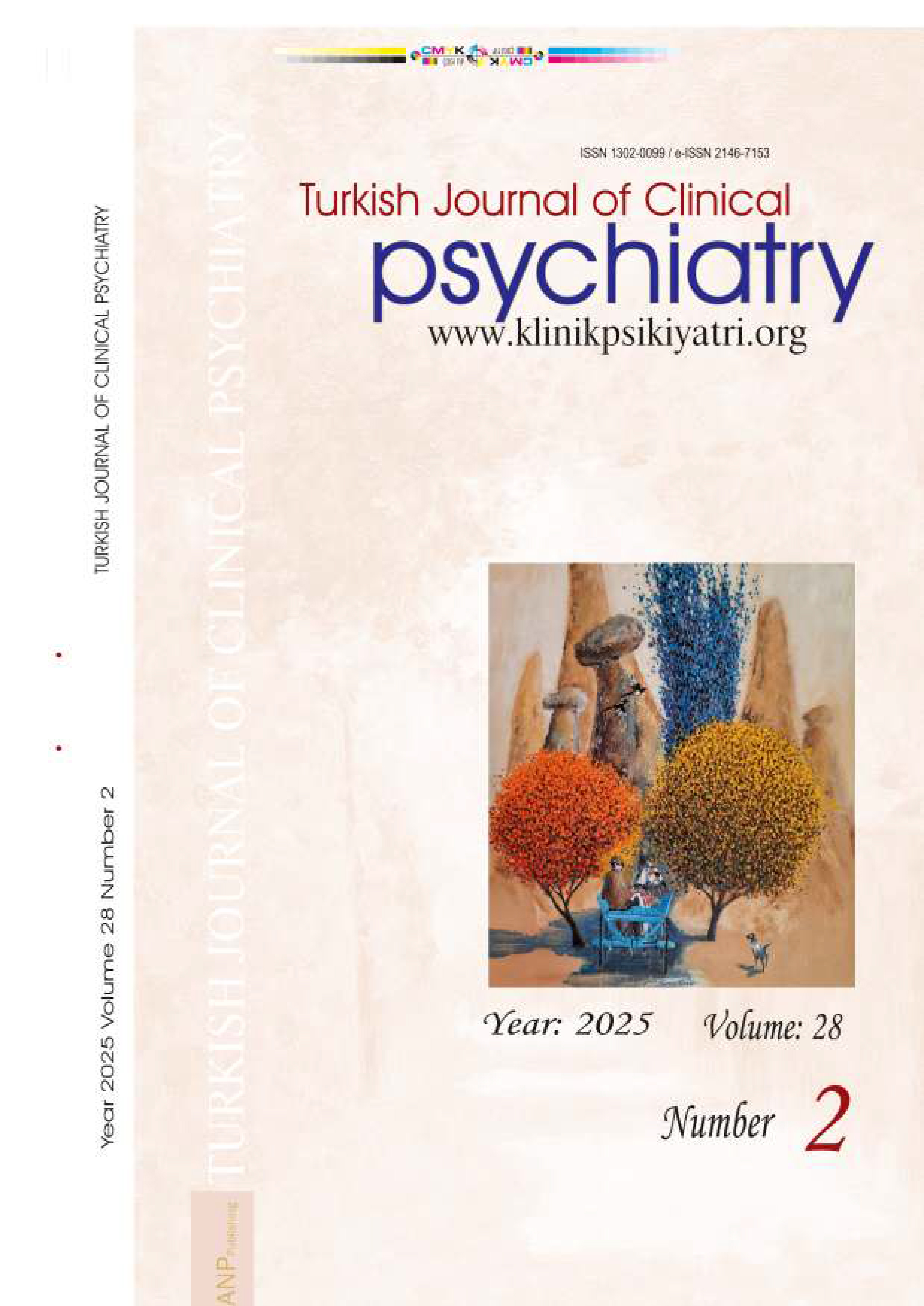





Volume: 4 Issue: 1 - 2001
| RESEARCH ARTICLE | |
| 1. | Adolescent Loneliness, Coping Methods and the Relationship of Loneliness to Suicidal Behavior Mehmet ESKİN Pages 5 - 11 This study investigated the prevalence of the feelings of loneliness, coping methods with loneliness, and the relationships between loneliness and suicidal attempts and thoughts in adolescents. The study sample consisted of959 high school students. Loneliness was measured with the short version of UCLA loneliness scale, and the question: "Are there moments during which you feel too lonely?". Sixty-five percent of the students responded affirmatively to the question "Are there moments during which you feel too lonely?". In addition, X33.2 of the sample scored above the mean of the UCLA loneliness scale. Students who exhibited suicidal behavior were found to be more lonely than those who did not exhibit suicidal behavior. Students, in a descending order, used the methods of participating in passive activities, seeking relationship, self-activation, reading-studying, and thinking-contemplating to cope with loneliness. |
| REVIEW | |
| 2. | Cognitive Dysfunctions Observed in Schizophrenia and Evaluation of this: A Review Nurper Erberk Özen Pages 12 - 24 Since the days of Kraepelin, many authors have tried to understand local cerebral lesions and dysfunctions characteristic of schizophrenic patients. Although some authors using neuropsy-chological tests have reported larger left hemispheric deficit, another group of researchers have reported more diffuse and non spesific variations seen in neurocognitive dysfunction. As a result of neuropsychological and imaging studies performed on animals and humans, it was though that attention deficits may be related to increased subcortical mesolimbic dopaminergic activity in connection with functionally reciprocal connections with the frontal lobe. Although there are various other tests demonstrating frontal lobe damage, the WCST is the only test known to be spesific to the dorsolateral prefrontal area. There is ample literature suggesting that the Wisconsin Card Sorting Test measures conceptual thinking and high level problem solving ability. |
| 3. | Treatment of Childhood and Adolescent Schizophrenia Selahattin Şenol Pages 25 - 37 The most consistent finding related to schizophrenia is its onset in the late adolescence or early adulthood. Schizophrenia, which takes places in the psychotic disorders of child and adolescents, is rather rare in this age group. Child and adolescent schizophrenia, also called early or very early onset schizophrenia, is accepted as more severe and more chronic form of the disease and suggested to reflect stronger biological aspect. In this paper schizophrenia in childhood and adolescent period will be reviewed in the light of literature, and handled under the topics of treatment, use of conventional and the atipical neuroleptics. |
| RESEARCH ARTICLE | |
| 4. | Mental Differences Between the Students and Teachers During the Training Process in Diving as a Sport Meral Berkem Pages 38 - 41 This research is planned to find out the psychological character-istics of the recreational scuba diving students who continue diving as a serious hobby and become instructors. Recreational scuba diving students and instructors were asked to fill Spielberg's State and Trait Anxiety Scales, Symptom Check List 40, Rosenbaum's Learned Resourcefulness Schedule, and Social Comparison Scale. 43 students and 23 instructors participated in the survey. The instructors' trait anxiety scores were lower, social comparison scores were higher than the students'scores. There was negative correlation between social comparison scores and state anxiety, positive correlation between social comparison scores and learned resourcefulness. 63.2 % of the students were prone to high risk sports. This rate was lover with 34.8 %for the instructors. The difference between the two percentages was significant. Recreational divers who are less anxious and satisfied with their position in society become instructors. Instructors have less risk taking behavior than the students and this comes out as a protective factor in training process of scuba students. |
| REVIEW | |
| 5. | Evaluating Treatment Resistance in Schizophrenia and Treatment Strategies in Resistant Cases Ali Kemal GÖĞÜŞ Pages 42 - 52 Evaluation and definition of treatment resistance in schizophrenia has gained importance since the introduction ofclozapin and the other atypical antipsychotics. Schizophrenic patients are sometimes considered as treatment resistant because of their poor compliance to medication, undermedication and chronic or frequent hospitalization. In fact there must be some other objective criteria for treatment resistance in schizophrenia. In order to identify patients as treatment resistant it is important to know how many drug trials should be made and, how long each trial should continue. The aim of this article is to summarize the recent literature on this issue. |
| 6. | Genetics of Schizophrenia İbrahim Ateş, Ercan ABAY Pages 53 - 59 Schizophrenia is a disorder which runs in families. Family, twins and adoption studies have demonstrated that inherited genetic factors are important in the development of schizophrenia.However, the pattern of inheritance is complex and it is not clear whether familial clustering in schizophrenia is due to one gene, a few genes or many genes. Genetic studies such as linkage and association studies are being carried out to explore the pattern of inheritance in schizophrenia. Great progress achieved in molecular genetic methods have motivated the researchers to engage in genetic studies. Therefore, genetic basis of schizophrenia will be better understood in the following century. In this article, first of all family, twins and adoption studies which are the classic methods of study have been reviewed. Theories about the mode of transmission is discussed and linkage and association studies are discussed. Experiences in genetic counselling and the principal approaches are presented |
| 7. | Early Onset Schizophrenia Elvan Özalp Balım Pages 60 - 70 Schizophrenia before the age of 12 years is very rare. The rate rises by late adolescence. Diagnosing of schizophrenia is more difficult in children and adolescents. Negative symptoms, insidious onset, male preponderance, premorbid schizotypic personality and severe brain dysfunction may well be more common, in early onset group. This article explains the early onset schizophrenia concept, in light of the neurodevel- opmental theory. |










